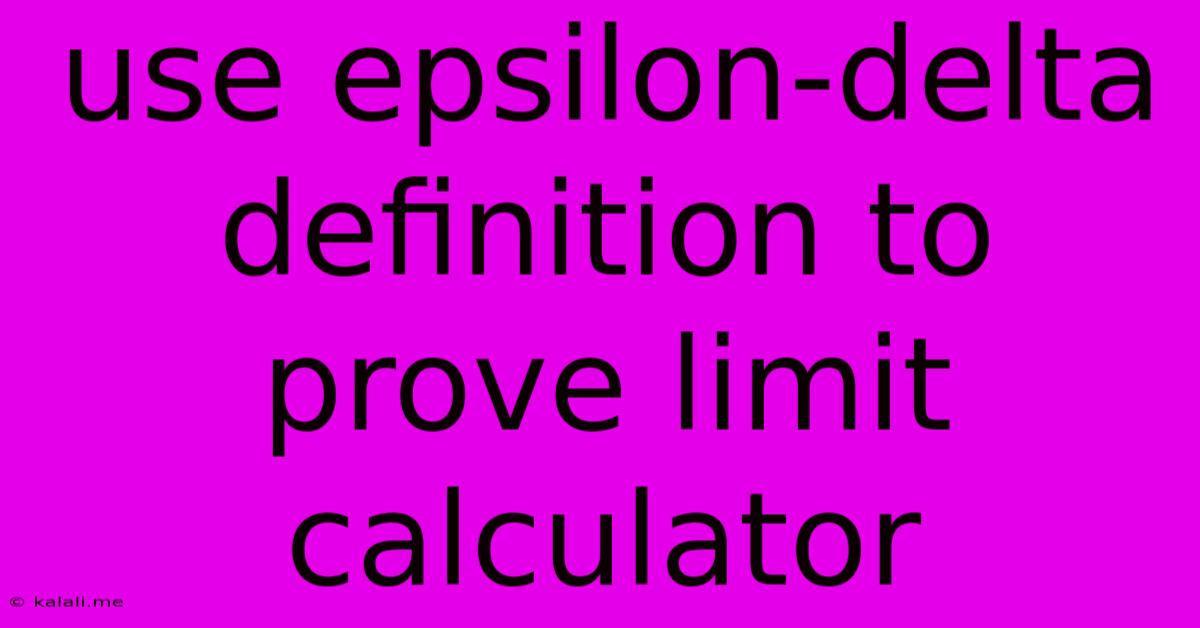Use Epsilon-delta Definition To Prove Limit Calculator
Kalali
Jun 01, 2025 · 3 min read

Table of Contents
Using the Epsilon-Delta Definition to Prove Limit Calculations: A Deep Dive
This article explores how the epsilon-delta definition of a limit is used to rigorously prove the results obtained from limit calculators. While calculators provide quick numerical approximations, the epsilon-delta approach offers a formal mathematical proof of the limit's existence and value. Understanding this process is crucial for a strong foundation in calculus. This guide will walk you through the process, focusing on both the theoretical understanding and practical application.
The epsilon-delta definition states that for a function f(x), the limit as x approaches a is L if for every ε > 0, there exists a δ > 0 such that if 0 < |x - a| < δ, then |f(x) - L| < ε. In simpler terms: we can make f(x) arbitrarily close to L (within ε) by choosing x sufficiently close to a (within δ).
Understanding the Components
Before diving into proofs, let's understand the key components:
-
ε (epsilon): Represents the desired level of accuracy. It defines how close we want f(x) to be to L. It's given beforehand.
-
δ (delta): Represents the proximity of x to a. It's the value we need to find to satisfy the condition. It depends on ε and the function f(x).
-
|x - a| < δ: This inequality ensures that x is within a distance δ of a, excluding a itself (0 < |x - a|).
-
|f(x) - L| < ε: This inequality ensures that f(x) is within a distance ε of L. This is the ultimate goal.
A Step-by-Step Approach to Epsilon-Delta Proofs
Let's illustrate the process with an example: Prove that lim (x→2) (3x - 1) = 5 using the epsilon-delta definition.
-
Start with the goal: We need to show that for any ε > 0, there exists a δ > 0 such that if 0 < |x - 2| < δ, then |(3x - 1) - 5| < ε.
-
Simplify the expression: |(3x - 1) - 5| = |3x - 6| = 3|x - 2|.
-
Relate the inequality to δ: We have 3|x - 2| < ε. To isolate |x - 2|, we divide by 3: |x - 2| < ε/3.
-
Define δ: We choose δ = ε/3. This ensures that if 0 < |x - 2| < δ, then 3|x - 2| < 3(ε/3) = ε, which satisfies the condition |(3x - 1) - 5| < ε.
-
Write the formal proof:
Let ε > 0 be given. Choose δ = ε/3. If 0 < |x - 2| < δ, then
|(3x - 1) - 5| = |3x - 6| = 3|x - 2| < 3δ = 3(ε/3) = ε.
Therefore, lim (x→2) (3x - 1) = 5.
More Complex Functions
For more complex functions, finding δ can be more challenging. It often requires careful manipulation of inequalities and the use of techniques like triangle inequality. For example, proving limits involving square roots or rational functions necessitates a more involved approach, potentially incorporating bounds and estimations.
The Importance of Epsilon-Delta Proofs
While limit calculators offer convenience, the epsilon-delta approach provides a rigorous mathematical foundation. It's essential for understanding the precise meaning of limits and developing a deeper grasp of calculus concepts. Moreover, this approach is crucial for tackling more advanced mathematical analysis and proof-based courses.
This article provides a foundational understanding of applying the epsilon-delta definition to prove limit calculations. Remember, practice is key; working through various examples with increasing complexity will solidify your understanding and skill in proving limits rigorously.
Latest Posts
Latest Posts
-
Initiating Processes Take Place During Each Phase Of A Project
Jun 02, 2025
-
Can Ground Beef Be Cooked From Frozen
Jun 02, 2025
-
Did Any Of Jesus Disciples Have Gets Married
Jun 02, 2025
-
Water Dripping From Exhaust Under Car
Jun 02, 2025
-
Change Light Fixture On Ceiling Fan
Jun 02, 2025
Related Post
Thank you for visiting our website which covers about Use Epsilon-delta Definition To Prove Limit Calculator . We hope the information provided has been useful to you. Feel free to contact us if you have any questions or need further assistance. See you next time and don't miss to bookmark.